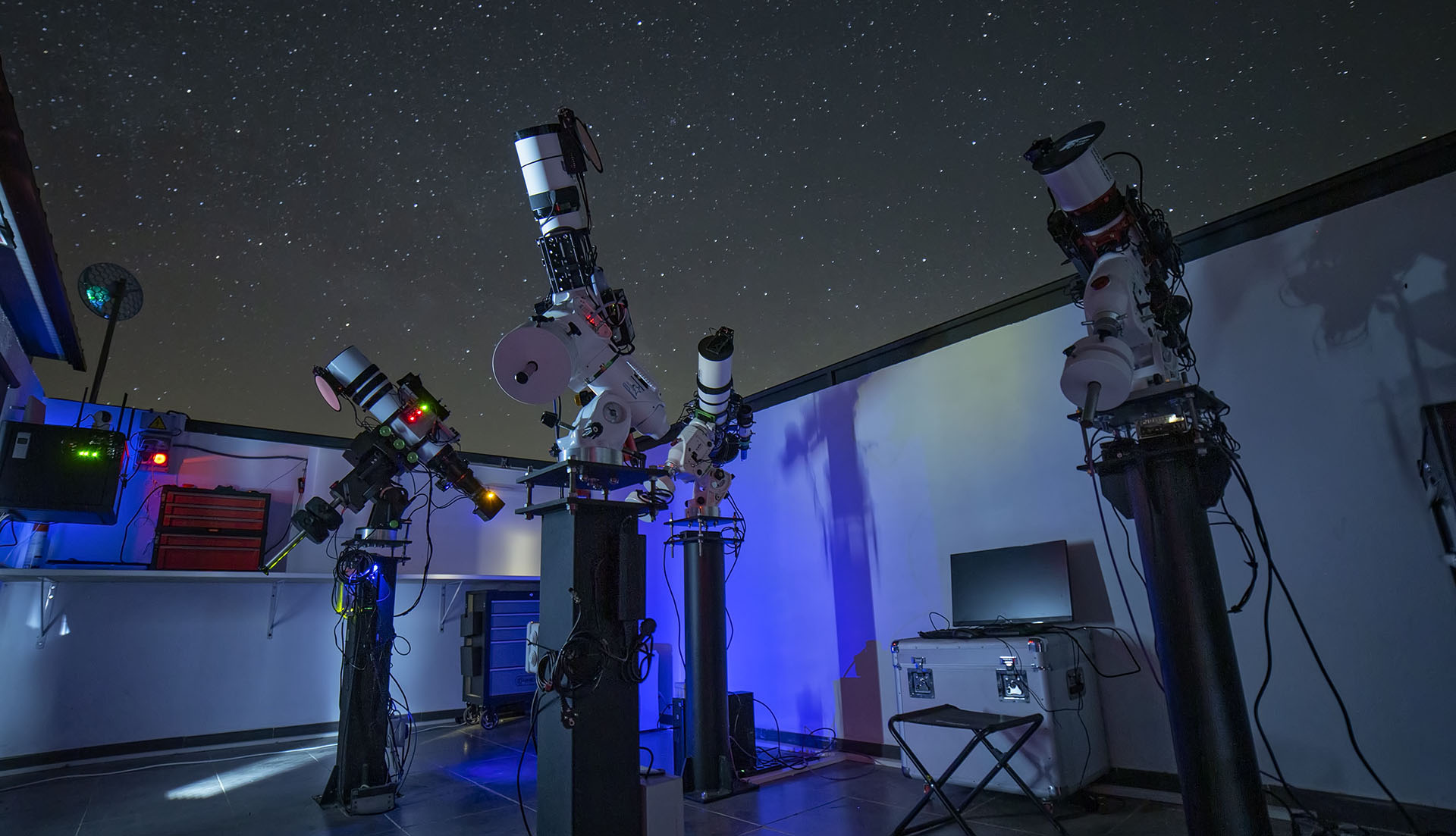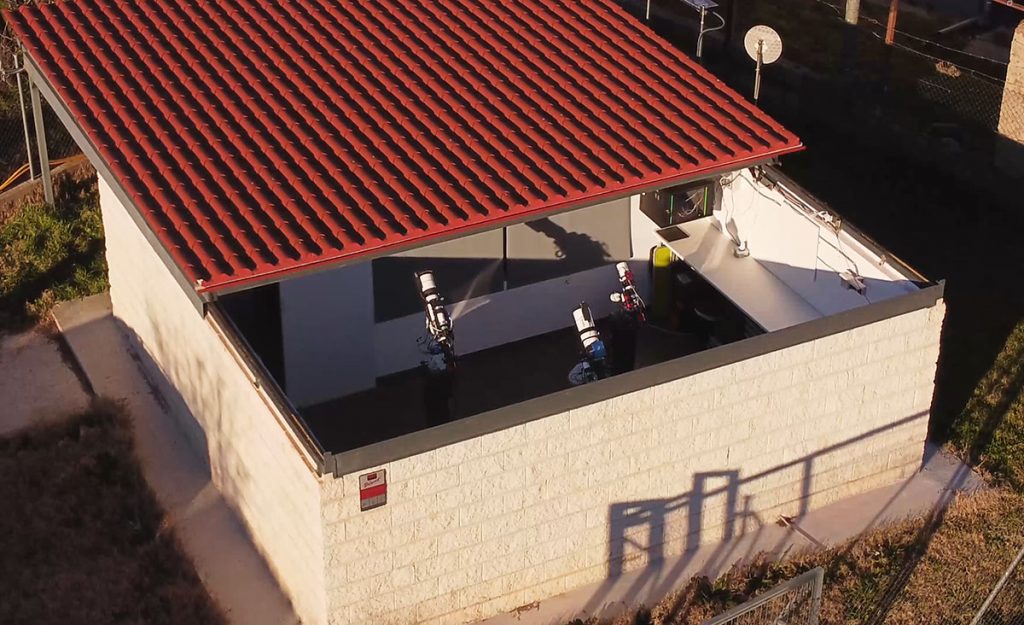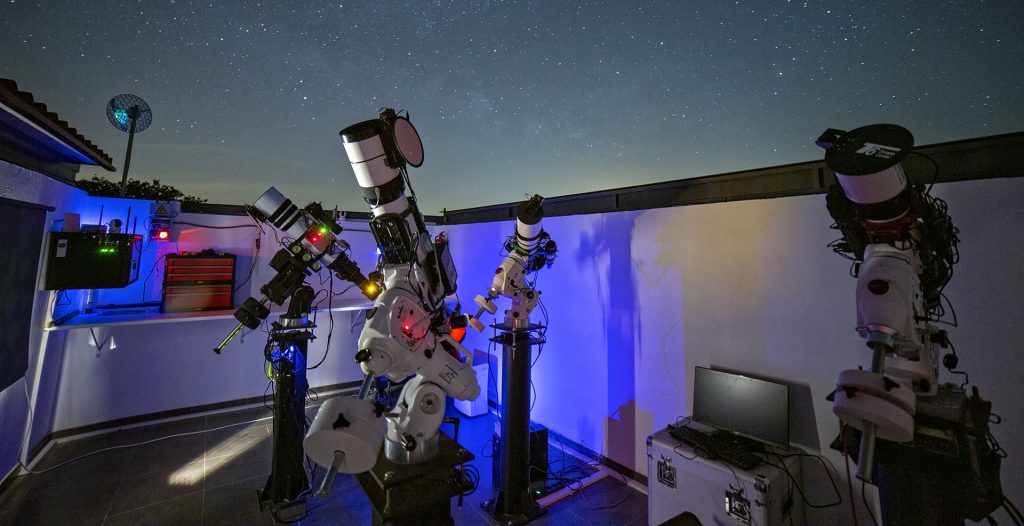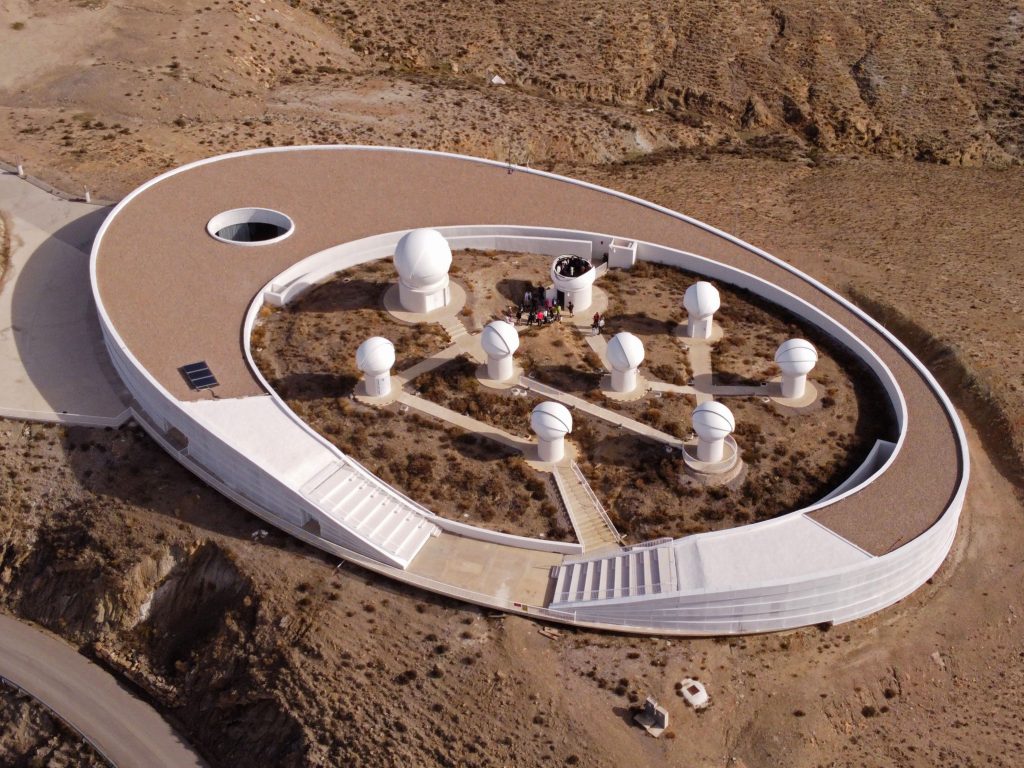
If we ask a number of astronomy and astrophotography enthusiasts what their greatest dream is in this hobby, a good percentage of them will answer that they would like to have their own observatory or a fixed place where they can keep their equipment permanently set up.
Indeed, amateur astronomical observatories have always been one of the things most desired by almost all amateurs. Something that very few have been able to achieve.
Fortunately, however, this is now changing. Because only a few years ago a type of observatory started to become popular, which now makes it easier for a large number of amateurs to have access to an installation of this type.
These are telescope hostings.
What is telescope hosting?
Imagínate tu propio observatorio astronómico ideal. ¿Cómo sería?
Imagine your own ideal astronomical observatory. What would it look like?
It would probably have a column or a place where we could install the astronomical equipment in a fixed and durable way. And of course a dome or a sliding roof that we could open during the astronomical observations and close once finished so that the equipment is fully protected. It would have all the necessary safety measures to protect the equipment from possible inclement weather. It would be located under a night sky specially selected for its high quality and darkness. It would have a suitable electrical installation to which we could connect our astronomical equipment and any other accessory we might need, such as a computer, and why not, an internet connection from which we could connect to the world to update our astronomical equipment, and even control it remotely.
This is telescope hosting. With the difference that instead of being built for your sole use and enjoyment, it is conceived so that a certain number of amateurs can have access to this experience of using our ideal astronomical observatory, depending on the number of seats available in the hosting.

Your ideal observatory more accessible than ever
Los hostings de telescopios son instalaciones que cuentan con todos los servicios y automatismos que exigiríamos en un observatorio astronómico Telescope hostings are facilities that have all the services and automatisms that we would require in a professional or semi-professional astronomical observatory.
- Meteorological station, which allows to monitor the atmospheric and meteorological situation 24 hours a day.
- Surveillance cameras, which not only monitor the perimeter of the observatory, but also control the situation of each astronomical equipment.
- All Sky cameras, providing a 360º view of the sky above the observatory
- Seeing monitors, with which to control the level of atmospheric turbulence at altitude
- Redundant systems, to monitor the situation surrounding the observatory 24 hours a day in order to safeguard the integrity of the installed equipment.
- Equipment maintenance, which guarantees the almost immediate resolution of any eventuality or update that may arise with the installed equipment.
- High-speed internet connection, with which to maintain fluid communication with our astronomical equipment.
In addition to these general key points of any installation of this type, we can find other specific particularities of each installation.
Nest hostings
These are installations that house a number of equipment located on the same site and under the same roof. These teams share not only the same location, but also other services and systems such as weather station, internet connection, surveillance cameras or all-sky camera, seeing monitor, and of course a common opening and closing of the roof. So our remote work will be conditioned to the opening and closing hours of the roof depending on the weather situation. This means that, whether or not we work with our astrophotographic equipment, the opening and closing of the roof will be determined by the hosting, and our work will have to adhere to those same hours.

Individual hostings
Individual hostings, as the name suggests, are individual installations per astrophotographic equipment, so that each equipment has its own cubicle and roof. These types of hostings also usually have certain systems shared among the different users, such as weather station, all-sky camera, and certain surveillance cameras, offering each user the possibility of installing extra cameras in each individual observatory. The main difference with respect to nest hosting is in the opening and closing times of the roof. In the case of individual hosting, it will be the user himself who decides when to open and close his observatory, independently of the work of the rest of the users. These openings and closings will only be subject to force majeure conditions due to adverse weather conditions.
Sliding roof
This system is one of the most common in most telescope hostings, as it is economical and its precision and efficiency has been amply demonstrated. It basically consists of a roof that can be moved on rails and driven by a motor, which allows the interior of the observatory and therefore the astrophotographic equipment to be uncovered. Its main advantages are that it requires little maintenance over time, and that it allows the astrophotographic equipment to acclimatise quickly thanks to the complete exposure of the interior of the observatory. The disadvantage is that it is a system that is more sensitive to the action of the wind, which can also affect the operation of the telescopes installed.
Domes
Domes are very rarely used in telescope hosting because they are expensive and require the use of completely individualised hostings with their own construction for each astrophotographic equipment. However, despite this, we can find some hostings that work in this way, such as the ‘Galáctica: Centre for the dissemination and practice of astronomy’, which has 7 domes for telescope hosting, which can be operated from the observatory’s own facilities or remotely. Among the dome facilities we can find different designs, such as the traditional dome, in which only one slit is opened and must be oriented in the same direction as the telescope is pointing, or the full-opening domes, whose orientation is totally independent of the direction in which the telescope is pointing. The main disadvantages of domes in telescope hosting are that they are very expensive to install and require regular maintenance. Their main advantage, especially in the case of a closed dome, is the protection they offer against windy situations. However, the domes are also sensitive to wind and in very windy situations it is also unfeasible to open them.

Telescope hostings are designed so that any astronomy and astrophotography enthusiast can benefit from all these services and systems required in a professional astronomical observatory without the need to make any direct investment, and only in exchange for a periodic fee whose cost and conditions will depend on each telescope hosting.
Astrogredos Observatory as an innovation hub for Cosmoescape Remote Telescopes
The Astrogredos Observatory was born as the dream of a number of astronomy and astrophotography enthusiasts who felt that the years of spending all night outdoors capturing images of the Universe and being cold were coming to an end and it was time to evolve towards a new way of capturing the night sky.
This new way of photographing the Universe would eventually become an astronomical observatory with 4 individual and fully autonomous stations for the installation of astronomical equipment, with an equipment control room, with a fully automated sliding roof and with all the automation and security systems necessary to remotely operate all the equipment from anywhere in the world with an internet connection.
But also the Astrogredos Observatory is, nowadays, more than just the dream of a few amateurs. Because the Astrogredos Observatory is currently the innovation hub of Cosmoescape Remote Telescopes, where all the technology that will later be implemented in the hosting of Cosmoescape telescopes is installed and tested.
Currently the Astrogredos Observatory has 5 fully operational astrophotographic equipments that are testing different aspects of the world of astrophotography. All of them are apochromatic refractor telescopes in different ranges and sizes. Thus we have 2 apochromatic triplet telescopes of 100mm aperture and focal lengths between 700mm and 550mm. These 2 telescopes are currently working in monochrome with different types of broadband and narrowband filters.
We also have a third apochromatic quintuplet telescope with 90mm aperture and 500mm focal length. The big difference of this equipment is that, compared to the other 2 refractors of 100mm, this 90mm refractor currently works in color with a set of special broadband and narrowband filters specific for color.
And finally, the Astrogredos Observatory has a fourth entry level telescope, a small apochromatic doublet telescope of 72mm aperture and 480mm focal length, mounted on a small Sky Watcher Star Adventurer GTI star tracker mount.
This telescope is being used to test the validity of a fixed and remote controlled telescope.
One of the key functions of this telescope within the Astrogredos Observatory is the testing of a remote control system through a ZWO Asi Air device that Cosmoescape is testing and will soon be available for commercialization.
This remote control system will not only allow the user of an Asi Air device to control his equipment installed in a fixed installation at a telescope hosting or at his own observatory, but will also allow remote control of the equipment anywhere in the world with mobile internet coverage.
If you want to know more about the Astrogredos Observatory as an innovation hub of Cosmoescape we recommend you to take a look at the following video that we have published in our Youtube channel:
Cosmoescape Telescope Hosting
Cosmoescape Remote Telescopes is a company entirely dedicated to the design, assembly and automation of robotic astronomical observatories. And with the support of the Astrogredos Observatory as an innovation hub we are developing all the engineering that will later be installed in the Cosmoescape telescope hosting.
The development of telescope hosting is the culmination of Cosmoescape’s professional activity, the possibility to offer any amateur the opportunity to enjoy their astrophotographic equipment in a radically different way.
Cosmoescape currently has a number of sites throughout Spain and is in the process of building a telescope hosting project. However, the first hosting will be inaugurated on land in Avila, and within the area of influence of the Starlight Reserve of the Sierra de Gredos.
This hosting will have, in its complete phase, 60 individual stations with their own sliding roof, 2 nest-type facilities with shared sliding roof and capacity for between 6 and 10 equipments each, and an area dedicated to astronomical observation and astronomy dissemination under one of the best night skies of the Iberian Peninsula.
The first fully autonomous individual stations will be available to welcome their first customers in the coming months.
